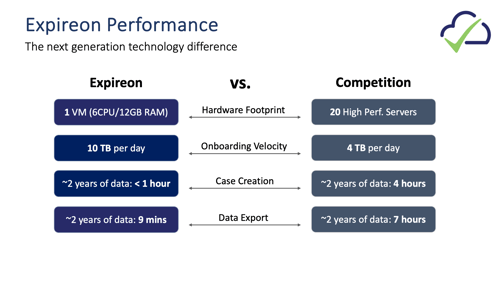Cloudficient continues to innovate with the introduction of a next generation cloud archive - Expireon. This innovation centers around paradigm shifts in the areas of indexing, data autonomy, and right-sized eDiscovery.

The first generation of cloud archives was created to address key challenges and needs emerging as organizations began to accumulate increasing amounts of data in on-premises archiving environments. Cloud archives allowed businesses to change from CapEx to OpEx, as well as free themselves from hardware provisioning and ongoing management.
As cloud archives age, companies often have pain points with time, risk, and cost. Most of these are centered around inefficiencies with indexing, vendor lock-in, and overlapping eDiscovery tools. Let’s look at each of these in detail.
Indexing
One of the main issues with legacy SaaS archives is the indexing architecture. Since archives have often been used for compliance or eDiscovery, rapid search is a high priority. Because of the need for search, and issues around indexing performance, all data was indexed upon ingestion.
There are a few disadvantages of indexing everything on ingestion:
- Overall speed of indexing: It’s got to be fast, very fast, to keep up with the high volume of data in large enterprises.
- Corruption over time: We’ve all seen indexes in popular legacy archiving systems ending up corrupt ‘for no apparent’ reason. This leads to re-indexing requirements which add time to the process.
- Re-indexing when technology changes: Rarely will a new technology natively read an old-style index, and if it does, that ‘old’ part of the index probably can’t take advantage of the new indexing technology.
Companies looking to move to the cloud were faced with a decision that mostly provided two paths, neither were ideal.
- Move data to a standard cloud file repository to guarantee that the data was properly retained, and available if it was needed for compliance or eDiscovery needs. You got what you paid for with this solution - a lower price tag meant limited insight. When Compliance or Legal teams needed to interrogate the data, it was quite an effort to get visibility into the content of the data. As we all know, time is money when it comes to compliance and legal.
- This led many companies to move to a cloud archive that promised very fast search capabilities since all data was indexed upon ingestion. The advantage was immediate search and high visibility, but this was countered with high costs, loss of flexibility, and loss of data autonomy.
Companies were essentially faced with deciding between two options; low cost with low visibility, or high visibility but at a much higher price.

Data Autonomy
Many companies soon found that getting large data sets out of these legacy cloud archives was a very expensive proposal. Since there was limited API access to these platforms, companies often had to rely on the professional services group of the vendor to perform exports when it came to a merger or acquisition, or if the company decided to move to another vendor. These costs would often average $8,000, or more, per Terabyte of exported data.
Then there is the issue of getting the data in a timely manner. Because data is often stored in a proprietary format, with no access via APIs, it could take excessive time to translate the data into a format that is both human and machine readable, and suitable for ingestion into a review platform. Delays at this stage of eDiscovery are at least inefficient and often unacceptable.
Right-sized eDiscovery
When the first generation of SaaS archive solutions was designed, there was a goal to facilitate the entire eDiscovery process end-to-end, where everything could be done in a single platform. The reality is that most companies will follow one of two workflows when it comes to eDiscovery:
- Perform a custodian-based export of data to pass to a downstream review tool. This generally does not include any culling at all, leaving the review and processing to more advanced tools where an investment has already been made. This review tool may be an in-house solution, or the data may be passed along to a Legal Service Provider (LSP) for further culling, review, and processing. This would result in larger data sets being passed to review, thus incurring large fees as most review tools and LSPs charge by the GB or TB of data under review. This led to the second workflow...
- Provide a first pass review of data, potentially culling the data set by keyword via what is known as Early Case Assessment or Early Data Assessment. Imagine being able to scour your data for specific keywords, and only exporting the most relevant results - that's the capability eDiscovery teams gain by moving beyond custodian-based searches. This would substantially reduce the cost of downstream review but would increase the cost of the solution since all data would be indexed on ingestion. Often the cost of the solution would match the potential savings in review, providing a near-even return on investment.
Next Generation SaaS Archive - Expireon
Due to technology advances, especially cloud technology, we at Cloudficient have found a way to provide the best of both worlds with our Expireon platform.
In a head-to-head comparison with a first-generation SaaS archive, we not only outperformed it in numerous areas (ingestion speed, index and search speed, export speed) but we also provided a much lower price point.

Expireon is a next generation cloud platform that solves typical pain points often found in first generation SaaS cloud archives, specifically in the areas of indexing, data autonomy, and eDiscovery:
- Targeted indexing – Indexing performance enhancements allow Compliance and Legal teams the option to perform indexing on demand. We have customers who bring hundreds of Terabytes to Petabytes into the Expireon platform. When these customers need to export data for eDiscovery, most either export data based on custodians and date range, or they target their keyword searches against only the custodians for that case or matter. Indexing the entire data set is a costly feature that may be rarely utilized. The core architecture of the Expireon platform was built to take advantage of the advancements in indexing technologies. Expireon is a flexible and efficient solution that is a perfect fit for multiple eDiscovery workflows:
- If your workflow consists of simply exporting custodian-based data without any keyword searches, you can export by custodian, date ranges, etc. without performing any indexing, saving you money in indexing costs.
- If you want to further cull data by performing keyword searches you can simply index ONLY the data for those custodians and date range, saving indexing costs across data sets that are not part of the investigation, and saving money by limiting the data that is exported and sent downstream for further review.
- Data Autonomy – First generation SaaS archives often hold your data hostage, requiring you to pay hefty fees to export large data sets, or if you simply want to take your business elsewhere. This is partially due to a lack of API access to the data, and partially because data is often stored in proprietary formats which are often unreadable by eDiscovery professionals or must be converted before export. We firmly believe the customer has total ownership of their data - it's a fundamental right. Data is always stored in native formats, and the customer can choose to store data within the Expireon cloud data centers, or within their own storage in a private cloud, or even on-premises. Since the customer owns the data, and all the encryption keys, they are free to not only move this data to another provider in the future, but they can also use this valuable data for other initiatives such as AI.
- Right-sized eDiscovery – When archive systems started moving to the cloud, there was a push to try to be an all-encompassing eDiscovery tool, spanning across the eDiscovery Reference Model from left to as far right as possible, including processing and review. Almost 100% of our customers prefer to capitalize on existing investments in review tools and are not interested in paying for tools that have overlapping features. Expireon provides eDiscovery professionals the ability to quickly export data based on custodians or key metadata information, or you can selectively index data for further culling via keywords, without having to pay to have a fully indexed data set.
The final piece to this puzzle is... how do you get your data migrated into this next-generation platform? Cloudficient has always been at the cutting edge of industry changing technologies. Data migration just got a whole lot easier, thanks to Cloudficient's innovative next-gen platform that's a giant leap forward. Our data migration technology is built into the Expireon platform, making onboarding simple, secure, and fast.
Cloudficient’s unrivaled, next generation migration technology is revolutionizing the way businesses retire legacy systems and transform their organizations into the cloud. Guiding customers through every step of the process, our expert team provides the support and solutions you need to succeed.
Bring Cloudficiency to your legacy data and cloud transformation: visit our website or contact us directly.
Editor's note: This post was originally published in January 2024 and has been updated for comprehensiveness.
.png?width=620&height=82&name=Untitled%20design%20(18).png)
.png?width=600&height=79&name=Untitled%20design%20(18).png)
-3.png?width=250&height=33&name=Untitled%20design%20(18)-3.png)


